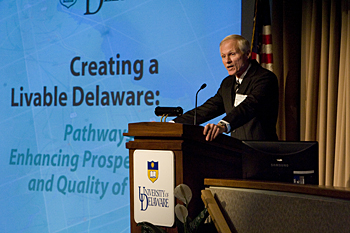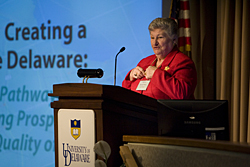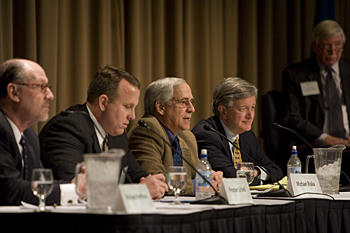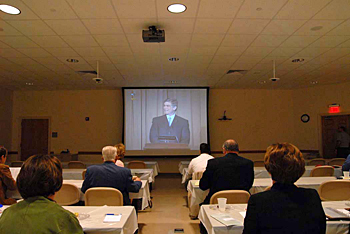
UD President Patrick Harker opened the conference, welcoming those attending on the Newark campus and via video links to the Carvel Research and Education Center in Georgetown. The conference drew more than 350 people.
During Harker's remarks, he announced that David Weir, director of the Delaware Biotechnology Institute, has been named director of the new UD Office of Economic Innovation and Partnerships that will open July 1. The office will encourage and enable innovation and entrepreneurship, grow and utilize and leverage UD's knowledge-based assets and create and capture new economic and community benefits, Harker said.
Gov. Ruth Ann Minner, who has put forward a Livable Delaware agenda for Delaware, addressed the conference, saying the population of the state, which grew by 20 percent from 1990-2000, now stands at 780,000 and is expected to grow to more than 1 million by 2030.
“We need to be prepared to meet the challenges of a growing population by guiding growth to the areas that are best suited for growth,” said Minner, whose initiative in collaboration with the General Assembly to create a livable Delaware aims to direct growth to areas that are best prepared, preserve farmland and open space, promote redevelopment, facilitate affordable housing and limit sprawl.
Keynote speaker William B. Chandler III, chancellor of the Delaware Court of Chancery, said Delaware's favorable geography, the industriousness of its people and “extreme livability” are some of the causes of the problems that the state faces today. For the complete text of the address and a video, see links at left.“The Delaware I was born into had a population of just slightly over 300,000 people: More than 100,000 in Wilmington, around 100,000 in the rest of New Castle [County] and less than 100,000 in all of Kent and Sussex counties combined,” Chandler, who grew up and still lives in Dagsboro, Del., said. “The population of the three counties today...is quickly approaching 800,000, a near threefold increase in my lifetime alone. A state cannot experience such dramatic growth in such a short period of time without feeling some growing pains.”
Chandler said the growing demand for housing by an influx of retirees and “tax refugees” from other states has transformed Sussex County by raising the average cost of a house to $260,000 while the average local income is only $30,000. As a result, he said, middle class families that once owned homes in Rehoboth Beach and Lewes can no longer afford them and traditional waterfront communities have been uprooted.

Quoting L.P. Hartley, author of The Go Between, who wrote that “the past is a foreign country,” Chandler said: “The Delaware I grew up in is a foreign country to today's world of urban planning, skyrocketing property values and conferences like this one, where strategies to manage growth and to preserve our cultural heritage are challenges to be addressed.”
Chandler said the driving force behind Delaware's “breakneck” pace of development was a combination of several factors, among them the state's attractive aesthetic qualities, low property taxes and a transfer tax system that benefits local governments that also have the authority to approve development.
“The system incentivizes local governments to pass congestion-friendly laws: The more units allowed per acre of land, the more potential transfers and the more sales and the more revenue generated,” Chandler said.Chandler said that the market has the potential to correct the problem if the state becomes so overcrowded and ugly that nobody will want to move in any more, but he said that allowing uncontrolled growth would “inflict irreparable harm” to the state. Instead, he suggested continued efforts by the state to purchase and preserve open spaces, the purchase of development rights, zoning restrictions and a moratorium on new developments.

Chandler also recommended reassessment of property values for tax purposes to close the “tax vacuum,” as well as pooling some or all transfer tax revenue into a trust fund for the preservation of open spaces through the purchase of development rights. He said that new developments should require the approval of local, county and state authorities to ensure the involvement of all parties that would be affected. New developments, he said, should either be approved based on the capacity of the infrastructure or on condition that the developer meets the cost of improving the same.
Chandler also suggested that the responsibility of developing and maintaining roads should be transferred from the state Department of Transportation to local authorities and traffic from nearby states should be made to pay through electronic toll collection.
Chandler's talk was followed by a panel discussion moderated by John Taylor, executive director of the Delaware Public Policy Institute. Panelists were Thomas Morr, president of Select Philadelphia; Michael Riska, executive director of Delaware Nature Society; Preston Schell, president of Ocean Atlantic Companies; and Richard Heffron, senior vice president for government affairs at the Delaware State Chamber of Commerce.

Riska said that to ensure a livable Delaware, citizens must “demand change and stand by those people who are ready to make tough decisions.”
Describing himself as a developer who loves “all things Delaware,” Schell said he agrees with many of Chandler's proposals. He added that Minner's Livable Delaware program has many strengths.
Heffron said he found much to like in Chandler's comments, although he would not support a moratorium on development. Several panelists noted that economic recession could provide a natural moratorium, of sorts.
The next conference in UD's "Creating Knowledge-Based Partnerships" series, slated for Oct. 2, will focus on education in Delaware.
The March 25 conference was cosponsored by the Office of the Governor, the Delaware State Chamber of Commerce, the Delaware Public Policy Institute, Delaware State University, Delaware Technical and Community College, First State Innovation, Select Greater Philadelphia, Nemours Health and Prevention Services and the News Journal.
Article by Martin MbuguaPhotos by Kathy Atkinson and Steven Billups


